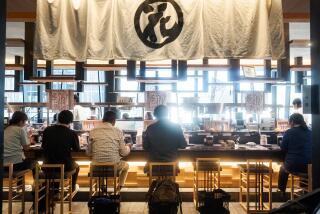Mugu Hosts 250 Soldiers From Japan
- Share via
POINT MUGU — Melody Rich doesn’t know much Japanese. But she knows some important words: Teishi means “hold,” as in don’t launch; midori is “green” for go, and shageki-- that’s “fire,” as in ready, aim, fire.
With the arrival of about 250 Japanese soldiers for testing and training at the Point Mugu Naval Air Station this month, shageki is the word that Rich, the base’s operations conductor, needs to know.
The Japanese groups--one testing and evaluating missiles, the other cycling soldiers through training on launches--come to Point Mugu simply because there isn’t enough room to shoot long-range missiles in their homeland, where the seas are busy with fishermen, and North Korea and China are mere miles away.
At home they must rely on simulations, no match for the actual hands-on experience the Japanese army would need should warfare be necessary. Besides, Point Mugu offers geography very much like Japan’s, according to the Japanese army officer responsible for test and evaluation.
“Point Mugu is the best place for launching from land or ocean,” Col. Yoshinobu Otani said through an interpreter. The ocean coastline is reminiscent of his country’s, and the Channel Islands off the coast mimic Japan’s islands.
The base has welcomed the Japanese each year for the past decade, as another means of keeping the base financially viable. The Germans, Norwegians and the English also have brought their armaments and paid for the opportunity to test them at Point Mugu, as have Army and Air Force units from throughout the United States.
Although officials would not disclose how much money the base makes from such visitors, the base Weapons Division is always looking for more foreign work, they said.
“This work is competitive,” said Chris May, the civilian engineer who supervises the testing program. “We’re looking to capture some of the market. And we have a huge infrastructure of the beach and at San Nicolas Island that makes us desirable.”
The Japanese could have gone to Australia, or tested at other American bases such as White Sands Missile Range in New Mexico or Eglin Air Force Base in Florida. The reasons for coming to Point Mugu are simple, said Col. Noriyuki Yoshida, the officer overseeing training. He said Point Mugu has sophisticated facilities, and it helps that Tony Matsuo, the program manager at the sea range, speaks Japanese.
“They are doing well for us,” Yoshida said through an interpreter. “We can do this smoothly.”
The Japanese bring their own equipment: trucks, missiles and the giant launchers, with six barrel-like tubes that lift toward the sky. The Americans and Japanese work together on the launch, sending missiles to targets at sea. The countdowns--in Japanese and English--are simultaneous.
It takes great effort and coordination. In a task that can be life or death, a misunderstanding is more than just a cultural joke.
“We use dictionaries. We write things down on paper. We use sign language,” said Rich, who oversees the minute-by-minute activity of the launch.
“When you’re making last-minute safety decisions, it could be really dangerous,” Matsuo added. “That’s why we have redundant safety measures. They drill, drill, drill.”
The Japanese soldiers live on base, though with very restricted clearance. They seem to like everything. They say California is beautiful and spacious, the golf is good and Point Mugu’s staff members are excellent. Even the Navy’s American cooking is good.
He might even prefer it to home, Otani joked.
“I asked Mr. Matsuo,” Otani said, “I said, ‘I want to live here.’ ”
More to Read
Sign up for The Wild
We’ll help you find the best places to hike, bike and run, as well as the perfect silent spots for meditation and yoga.
You may occasionally receive promotional content from the Los Angeles Times.






